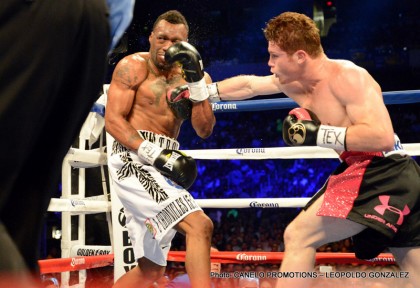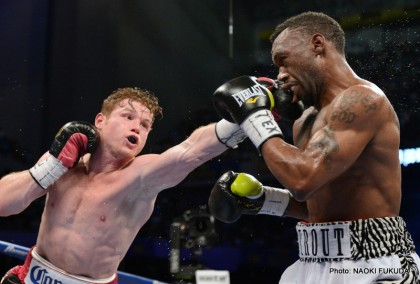 The best way to score a boxing match would probably be to have each fighter begin the event by punching all three judges (jabs, uppercuts, straights, hooks, etc.) to aid the judges in answering the mythical question hanging over every fight of punch valuation—how many of fighter A’s jabs equal an uppercut of fighter B, etc.. Now, there are many practical concerns with enacting such a policy—for example, who will judge the fight should the judges get knocked out? So, absent that, the next most logical way seems to be to simply watch how each fighter responds to other’s punches—thereby sorting out not only when a punch is thrown, but whether it lands in a clean, effective manner. Fortunately, the human body reacts in predictable ways when struck with clean, effective punches—knees buckle, the head gets snapped back, the body is staggered, or in some cases knocked down.
The best way to score a boxing match would probably be to have each fighter begin the event by punching all three judges (jabs, uppercuts, straights, hooks, etc.) to aid the judges in answering the mythical question hanging over every fight of punch valuation—how many of fighter A’s jabs equal an uppercut of fighter B, etc.. Now, there are many practical concerns with enacting such a policy—for example, who will judge the fight should the judges get knocked out? So, absent that, the next most logical way seems to be to simply watch how each fighter responds to other’s punches—thereby sorting out not only when a punch is thrown, but whether it lands in a clean, effective manner. Fortunately, the human body reacts in predictable ways when struck with clean, effective punches—knees buckle, the head gets snapped back, the body is staggered, or in some cases knocked down.
The Canelo Alvarez—Austin Trout tilt from Saturday night bears, according to some, the “controversial” label, but it shouldn’t. Though Alvarez found his target less frequently than Trout (124 versus 154 in total punches landed), he clearly landed more of the clean, effective punches described in the above paragraph—and if you didn’t see that then you either didn’t watch the whole fight, are one of the two judges who somehow thought Chavez swung-and-missed his way to a draw with Whitaker a decade ago, or got distracted trying to figure out if Trout has a Mohawk or just a receding hairline that looks like a Mohawk—while Trout held a decisive edge in insignificant punches landed (the kind where the guy getting hit doesn’t react or seem to care).
continue

 The best way to score a boxing match would probably be to have each fighter begin the event by punching all three judges (jabs, uppercuts, straights, hooks, etc.) to aid the judges in answering the mythical question hanging over every fight of punch valuation—how many of fighter A’s jabs equal an uppercut of fighter B, etc.. Now, there are many practical concerns with enacting such a policy—for example, who will judge the fight should the judges get knocked out? So, absent that, the next most logical way seems to be to simply watch how each fighter responds to other’s punches—thereby sorting out not only when a punch is thrown, but whether it lands in a clean, effective manner. Fortunately, the human body reacts in predictable ways when struck with clean, effective punches—knees buckle, the head gets snapped back, the body is staggered, or in some cases knocked down.
The best way to score a boxing match would probably be to have each fighter begin the event by punching all three judges (jabs, uppercuts, straights, hooks, etc.) to aid the judges in answering the mythical question hanging over every fight of punch valuation—how many of fighter A’s jabs equal an uppercut of fighter B, etc.. Now, there are many practical concerns with enacting such a policy—for example, who will judge the fight should the judges get knocked out? So, absent that, the next most logical way seems to be to simply watch how each fighter responds to other’s punches—thereby sorting out not only when a punch is thrown, but whether it lands in a clean, effective manner. Fortunately, the human body reacts in predictable ways when struck with clean, effective punches—knees buckle, the head gets snapped back, the body is staggered, or in some cases knocked down.  The slick boxing Trout did what he was supposed to do. In front of 40,000 plus fans at the Alamodome, San Antonio, Texas, he controlled the distance and pace with his jab. He mixed it up, going often to the body. He threw more punches, displayed better combination punching, but he still lost the fight! How could that happen?
The slick boxing Trout did what he was supposed to do. In front of 40,000 plus fans at the Alamodome, San Antonio, Texas, he controlled the distance and pace with his jab. He mixed it up, going often to the body. He threw more punches, displayed better combination punching, but he still lost the fight! How could that happen? The highly anticipated junior middleweight unification showdown between WBC champion Saul Alvarez and WBA titlist Austin ‘No Doubt’ Trout started on a dramatic note before the action even got underway. The atmosphere at the Alamodome was simply electrifying. The high energy and intensity that exuded during the build-up to the opening bell was so powerful that it could even be felt by the television viewing audience, and it was contagious. Although this was not a hugely publicized contest that created massive appeal among casual fans, the entire event still possessed a magical mainstream vibe that almost helped make it seem far larger in its actual scope. The stage seemed set for something special.
The highly anticipated junior middleweight unification showdown between WBC champion Saul Alvarez and WBA titlist Austin ‘No Doubt’ Trout started on a dramatic note before the action even got underway. The atmosphere at the Alamodome was simply electrifying. The high energy and intensity that exuded during the build-up to the opening bell was so powerful that it could even be felt by the television viewing audience, and it was contagious. Although this was not a hugely publicized contest that created massive appeal among casual fans, the entire event still possessed a magical mainstream vibe that almost helped make it seem far larger in its actual scope. The stage seemed set for something special. I must say I’m really disappointed in WBC junior middleweight champion Saul “Canelo” Alvarez’s performance tonight in his controversial 12 round unanimous decision over WBA junior middleweight champion Austin Trout (26-1, 14 KO’s) at the Alamodome in San Antonio, Texas.
I must say I’m really disappointed in WBC junior middleweight champion Saul “Canelo” Alvarez’s performance tonight in his controversial 12 round unanimous decision over WBA junior middleweight champion Austin Trout (26-1, 14 KO’s) at the Alamodome in San Antonio, Texas. Not long to go now until tonight’s action packed evening of boxing action gets underway!
Not long to go now until tonight’s action packed evening of boxing action gets underway! After the final press conference concluded, Saul “Canelo” Alvarez took the time to partake in brief one-on-one interviews. I had the unique privilege to sit down with the Mexican superstar to get his perspective on the upcoming fight in San Antonio, TX.
After the final press conference concluded, Saul “Canelo” Alvarez took the time to partake in brief one-on-one interviews. I had the unique privilege to sit down with the Mexican superstar to get his perspective on the upcoming fight in San Antonio, TX. After the final press conference concluded, Saul Alvarez and Austin Trout took the time to address members of the media for one-on-one and roundtable interviews. I, along with other media correspondents, took the exclusive opportunity to sit down with the WBA champion.
After the final press conference concluded, Saul Alvarez and Austin Trout took the time to address members of the media for one-on-one and roundtable interviews. I, along with other media correspondents, took the exclusive opportunity to sit down with the WBA champion. The state of Texas is once again on the boxing spotlight: Saul Alvarez VS Austin Trout fight week has finally arrived in San Antonio, TX!
The state of Texas is once again on the boxing spotlight: Saul Alvarez VS Austin Trout fight week has finally arrived in San Antonio, TX! By Steve Lopez — After the press conference in Houston, TX concluded, Saul Alvarez and Austin Trout took the time to address members of the media for brief one-on-one interviews. I had the opportunity to sit down with Austin Trout to get his perspective on the fight, Canelo’s mission to avenge his older brother’s loss and what the future may hold for the New Mexico native.
By Steve Lopez — After the press conference in Houston, TX concluded, Saul Alvarez and Austin Trout took the time to address members of the media for brief one-on-one interviews. I had the opportunity to sit down with Austin Trout to get his perspective on the fight, Canelo’s mission to avenge his older brother’s loss and what the future may hold for the New Mexico native.